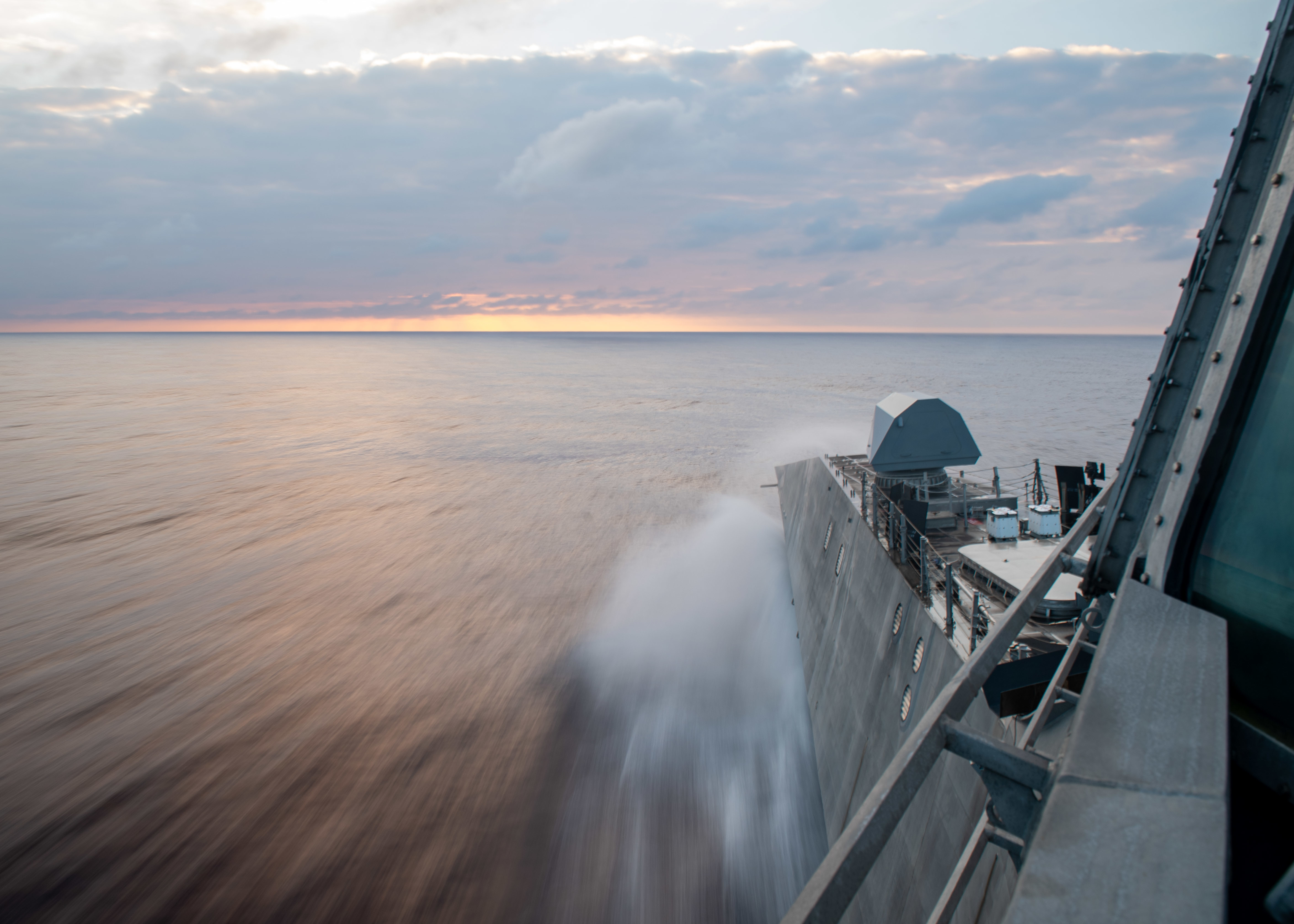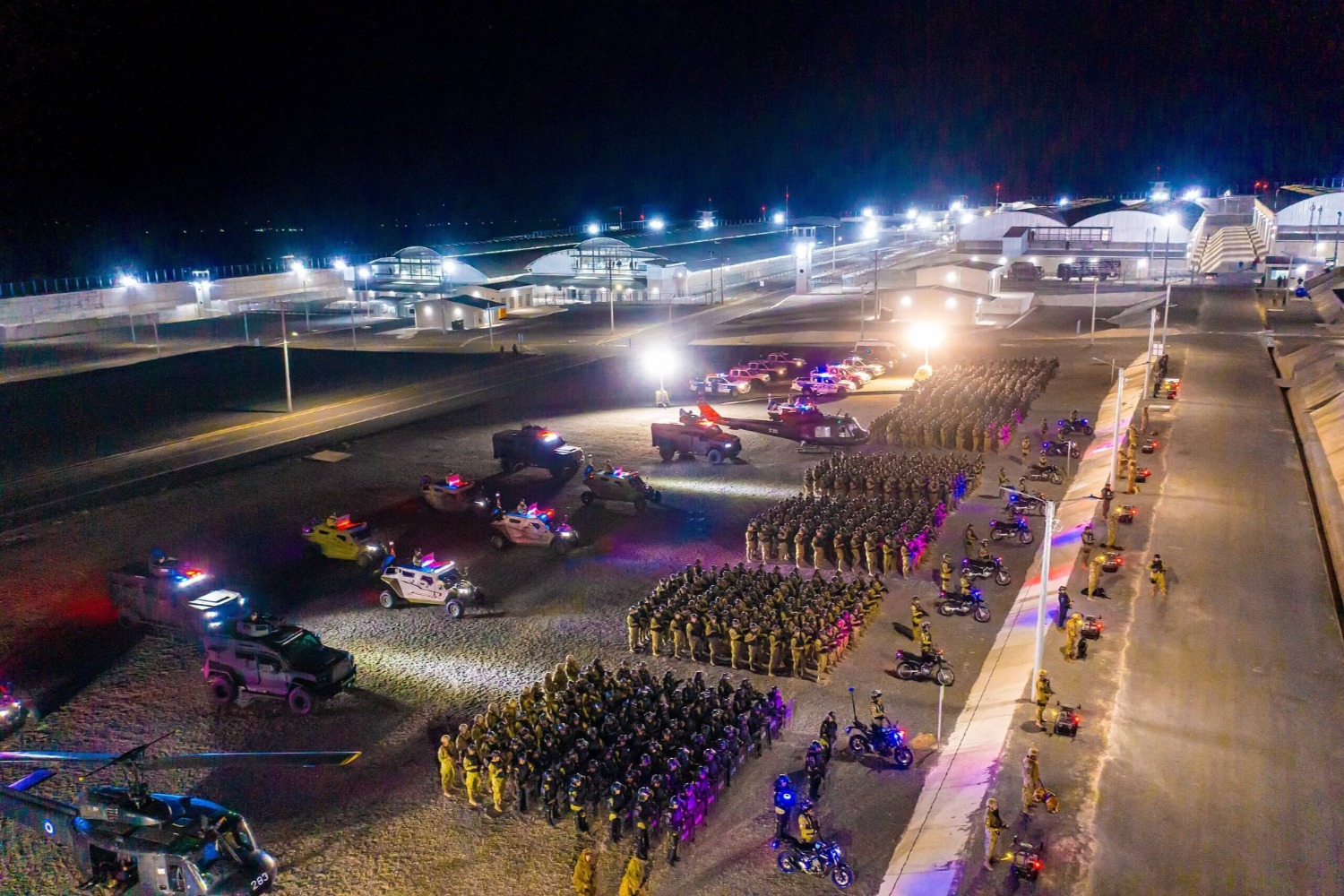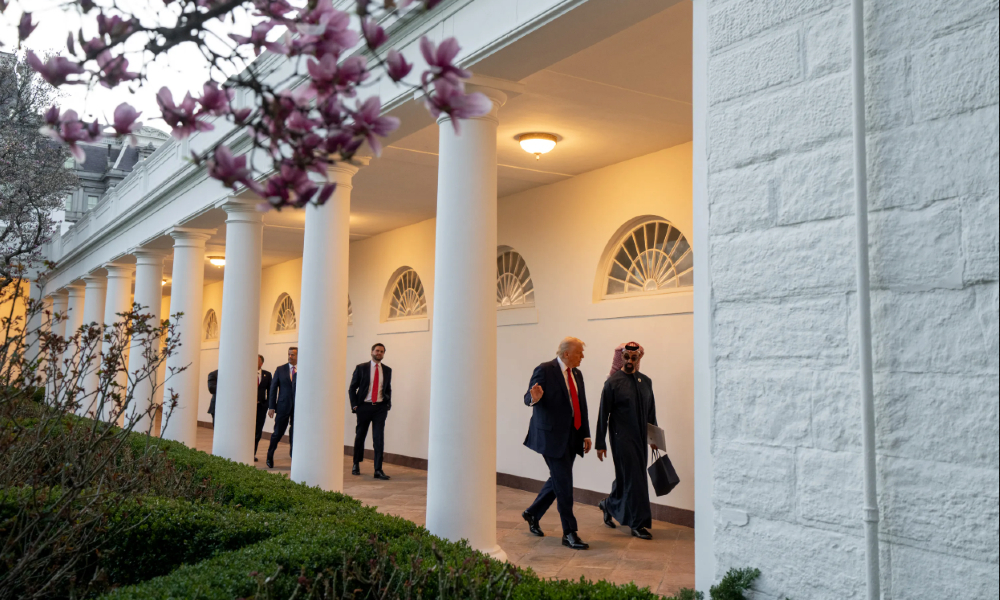Water Wars: Biden Administration Releases New Indo-Pacific Strategy
The Biden administration releases its Indo-Pacific Strategy; Australia protests Chinese warship lasing of Australian maritime patrol aircraft in Australia’s exclusive economic; and more.

Published by The Lawfare Institute
in Cooperation With

U.S. Announces New Indo-Pacific Strategy With a Focus on Building Regional Partnerships
On Feb. 11, the Biden administration announced its new Indo-Pacific Strategy. The 19-page document, released during Secretary of State Antony Blinken’s visit to the Indo-Pacific, outlines Biden’s vision of U.S. engagement in the region and focuses on sustained collaboration with allies, partners and institutions both within and beyond the region. The Biden administration has framed the strategy as an attempt to “shape the strategic environment” of a rising China. It is not hard to see that Biden hopes this multilateral strategic vision will allow the U.S. and its allies to respond more effectively to Chinese maritime aggression.
Biden’s strategic perspective builds on that of previous administrations, especially President Obama’s “Rebalance” strategy and President Trump’s “Free and Open” strategy and Strategic Framework. Biden’s Indo-Pacific strategy continues to support several regional priorities that the Trump administration embraced, including strengthening a network of regional allies, increasing diplomatic engagement in the region, fostering economic prosperity and building digital infrastructure. Both also note the danger of China’s pattern of undermining the sovereignty of Indo-Pacific partners. The Trump administration’s protectionist attitude toward traditional regional allies and indifference to global challenges such as climate change, however, muddied its implementation.
Regarding security, Biden’s Indo-Pacific strategy emphasizes “integrated deterrence” as the “cornerstone of [its] approach” to counter coercion at land and at sea, and to innovate in space, cyberspace and other evolving threat environments. On the economic front, the strategy proposed an Indo-Pacific economic framework to fill the gaps left by President Trump’s decision to leave the Trans-Pacific Partnership. Most notably, the strategy details the administration’s plan to expand and deepen regional alliances and partnerships by investing diplomatic and economic resources in the Pacific Islands and deepening relations between NATO allies and the Indo-Pacific.
The Biden Indo-Pacific strategy forcefully rejects the Trump administration’s “America First” approach, which strained relations with partner countries over trade and defense funding. For example, the Biden strategy reaffirms the half-century-old One China Policy but frames Taiwanese independence as affecting broader regional stability and calls for “a team effort” by “partners inside and outside the region.” Biden’s call for allies to counterbalance China came one week after China and Russia declared a “no limits” strategic partnership, pledging to work together on a number of issues including security, space, climate change, the internet and artificial intelligence.
Strategic competition with Beijing looms even in parts of the document that don’t explicitly mention China. The Biden strategy emphasizes the need for multilateralism in Indo-Pacific stability, highlighting the Association of Southeast Asian Nation’s (ASEAN’s) role in addressing “the region’s most pressing challenges” and “an increasing regional role for the European Union.”
Chinese government officials and state-owned media, however, disagree with the strategy’s new regional framing. Foreign Ministry Spokesperson Wang Wenbin said that the U.S. Indo-Pacific strategy “resurrects the Cold War mentality” and “will only bring division and turbulence to the Asia-Pacific.” Li Haidong, a professor from the Institute of International Relations of China Foreign Affairs University, stated that instead of using the words “China” and “democracy,” the new strategy “in a crafty way overstates ‘partnership’ and ‘alliance’ in an attempt to tout for support and understanding from the American public, its allies and media.”
At bottom, Biden’s Indo-Pacific strategy takes more serious account of the region’s concerns, bolstering its efforts to recruit partners and allies in that endeavor. Whether and when Congress will fund these initiatives is an open question, but the strategy nonetheless provides helpful insight into the Biden administration’s priorities going forward.
U.S. Makes a Push for Greater Diplomatic Engagement in the Pacific
The Biden administration has already taken steps to address the dearth of diplomatic engagement in the Pacific through long-overdue visits to island countries and the establishment of new embassies. Blinken’s trip to Fiji, Australia and Hawaii was meant to signal a prioritization of the Asia-Pacific. Blinken became the first U.S. secretary of state to visit Fiji in 36 years. During the visit, Blinken announced that the U.S. would open an embassy in the Solomon Islands, the largest Pacific Island nation without an embassy. Leaders of Pacific Island nations appear to welcome the renewed American engagement. Fiji’s acting prime minister, Aiyaz Sayed-Khaiyum, noted the United States’ “very strong philosophical commitment” to increasing engagement, in sharp contrast to previous treatment as merely “small dots spotted from plane windows.”
Such commitments may reflect the United States’ ongoing concern about China’s attempt to gain influence in the sparsely populated yet strategically crucial region. The Solomon Islands recently experienced severe unrest, driven in part by anti-China sentiments arising from Prime Minister Manasseh Sogovare’s efforts to forge closer ties with Beijing, three years after switching diplomatic recognition from Taiwan to China. And in Melbourne, before Blinken headed to Fiji, the Quad members (the U.S., India, Australia and Japan) pledged to strengthen cooperation to free the Indo-Pacific region from “coercion,” referencing China’s economic and military expansion.
Australian Maritime Patrol Aircraft Lased by PLAN Warships
On Feb. 17, an Australian Defence Force P-8A Poseidon maritime patrol aircraft was harassed by a laser originating from one of two Chinese People’s Liberation Army Navy (PLAN) vessels sailing east through the Arafura Sea to the Coral Sea. The PLAN vessels involved in the incident were identified as the Luyang-class destroyer CNS Hefei and the Yuzhao-class amphibious transport dock CNS Jinggang Shan.
The incident occurred within Australia’s northern exclusive economic zone (EEZ). Under the U.N. Convention on the Law of the Sea (UNCLOS) Articles 58 and 87, vessels are entitled to freedom of navigation within another country’s EEZ, and Australia has acknowledged that PLAN vessels have “every right” to be there. Australia, however, also asserts its own right to conduct surveillance of ships within its EEZ.
Both Australia and China are parties to the 1995 Protocol on Blinding Laser Weapons, a U.N. convention that prohibits most combat uses of lasers that cause permanent blindness. Even in cases not prohibited by the convention, shining lasers at aircraft is considered a serious safety hazard; if the pilot’s vision is impacted, it could adversely affect the pilot’s ability to safely operate the aircraft. More troublingly, a laser could be used as a rangefinder indicating intent to fire a weapon at the aircraft. The Chinese state-run news outlet Global Times brushed off these concerns as “knowingly hyped” for the purpose of “throwing mud” at China, and emphasized that lasers are often used for civilian purposes and are not very dangerous. Australia contends that the lives of Australian Defense Force personnel could have been endangered and has called for an investigation of the incident and an explanation from Beijing.
At the time of the incident, the P-8A Poseidon was tracking and surveilling the two PLAN vessels in the waters north of Australia. Australia’s Ministry of Defence confirmed that the aircraft approached no closer than 4 kilometers from the PLAN vessels, which the ministry described as a “standard flight profile … for visual investigation of a surface vessel.” At the moment the aircraft was illuminated by the laser, it was 7.7 kilometers from the vessels. Australian Prime Minister Scott Morrison condemned the PLAN’s actions, calling them “reckless for a professional navy” as well as “intimidating and bullying.”
China has not confirmed use of the laser. Foreign Ministry Spokesperson Wang Wenbin maintains that the PLAN vessels were lawfully present in the area and acted in accordance with international law and practice, and that Australia’s claims are “pure disinformation.” The Global Times asserts that this alleged disinformation is meant to discredit China due to Australia’s discomfort with the “concrete benefits” (namely, disaster relief and coronavirus aid) that China provides to neighboring countries. China maintains that the P-8A’s close-in surveillance of the PLAN vessels was a provocation. A spokesperson for China’s Ministry of National Defense also condemned as provocative the P-8A’s deployment of a sonobuoy—a sonar device often used to detect submarines—an action that Australia says the P-8A took only after the lasing incident occurred. China demands that Australia stop provocative actions so as not to deteriorate the relationship between the two countries and cause “misunderstandings and misjudgments.”
The Australian Defence Force noted an increase in lasing incidents, making this the latest in an apparent trend in the region. In the past, Australian pilots have been targeted by commercial lasers while operating over the South China Sea, where China is known for taking aggressive actions. This recent incident, however, is unusual in that it took place outside the South China Sea and, according to Australia, involved a “military grade laser” from a Chinese warship. Tensions have increased between Australia and China since late 2021, when Australia entered into AUKUS, a new security agreement with the U.S. and the U.K. under which Australia will receive nuclear-powered submarine technology. Under the agreement, the U.S. will help Australia develop at least eight nuclear-powered submarines, increasing Australia’s naval capability. The underlying goal of AUKUS appears to be countering China’s naval influence in the region, which China views as an escalation.
Heightened Security Within the Indo-Pacific
Quad
The Quad met in Melbourne, Australia, on Feb. 11 for a routine meeting and again, virtually, on March 4 to discuss the Russian invasion of Ukraine. A joint statement released after the February meeting reaffirmed the four nations’ commitment to supporting a “free and open” Indo-Pacific “in which states strive to protect the interests of their people, free from coercion.” The statement confirmed the states’ beliefs that international law is the backbone to regional security. “The Quad recognises that international law, peace, and security in the maritime domain underpins the development and prosperity of the Indo-Pacific. We reiterate the importance of adherence to international law, particularly as reflected in the UN Convention on the Law of the Sea (UNCLOS), to meet challenges to the maritime rules-based order, including in the South and East China Seas.”
Although Quad member-states routinely criticize China for disobeying UNCLOS, Secretary Blinken rejected the notion that the purpose of the informal alliance among the U.S., Australia, Japan and India is to counter China. Instead, during an interview after the February meeting, Blinken stated that the Quad “is about standing up for a rules-based order, making sure that we uphold those rules and principles if they’re being challenged.” China, of course, rejects this notion and—according to the state mouthpiece Global Times—sees the Quad as “a sinister gang of [the] Indo-Pacific” designed to “encircle China.”
Quad leaders also met on March 4 to discuss the Russian invasion of Ukraine. President Biden and his colleagues agreed that a similar situation should not occur in Asia. Japanese Prime Minister Fumio Kishida said, “We’ve agreed that unilateral changes to the status quo with force like this should not be allowed in the Indo-Pacific region.” The joint statement released after the meeting, however, did not mention Taiwan specifically.
Japan
During an interview in late February, former Japanese Prime Minister Shinzo Abe stated that Japan should consider hosting nuclear weapons. “Japan is a signatory to the Nuclear Non-Proliferation Treaty and has its three non-nuclear principles, but it should not treat as a taboo discussion on the reality of how the world is kept safe.”
Japan’s non-nuclear principles disallow the possession or production of nuclear weapons within the country’s territory, and polling suggests Japanese citizens remain against the country maintaining its own nuclear arsenal. Abe, however, suggested that the public may be more amenable to a nuclear sharing agreement, similar to NATO arrangements, which lets the U.S. house and share nuclear weapons with European allies that do not possess their own nuclear arsenal.
Abe’s comments came mere days after Russia’s invasion of Ukraine. The former prime minister suggested that if Ukraine had maintained some of its nuclear weapons after the breakup of the Soviet Union instead of trading them for a security guarantee, then it might not have faced Russian invasion.
India
In February, India appointed retired Vice Adm. G Ashok Kumar as the country’s first national maritime security coordinator (NMSC). Although the specific scope of Kumar’s position is not yet public, the Times of India reported that the NMSC will serve under India’s national security adviser and work to “ensure effective coordination and cooperation among multiple central and state authorities dealing with the domain from the coast to the high seas.” These authorities likely include the navy, the coast guard and intelligence agencies.
The need for an effective maritime management system has been stressed repeatedly by Indian officials since the turn of the century. In response to the Kargil War, the Group of Ministers called for “an apex body for the management of maritime affairs” in 2000. India’s economic prosperity and national security inherently rely on maritime security. The country’s coastline spans 7,516 kilometers (4,670 miles) with 90 percent of Indian trade transits by ocean. Naval experts also speculate that China’s PLAN is developing both an Indian Ocean fleet and an Indian Ocean strategy.
India is also expanding its military diplomacy in response to China’s growing naval influence. India’s 2022 MILAN naval exercise, a biennial multilateral event, was the largest since its inception in 1995, with 40 countries participating—13 of which sent warships. The participation of both the Quad member-states as well as regional countries such as Vietnam, Myanmar, and Bangladesh underscores the international community’s growing concern over recent Chinese expansionism.
U.S. Reassures Taiwan as Tensions Simmer
President Biden dispatched a high-profile, bipartisan group of former U.S. defense and national security officials to Taipei in a “sign of support for the island claimed by China after Russia's invasion of Ukraine.” The delegation—led by retired Adm. Mike Mullen, chairman of the Joint Chiefs of Staff under Presidents George W. Bush and Barack Obama; Meghan O’Sullivan, a deputy national security adviser under Bush; and Michele Flournoy, a former undersecretary of defense under Obama—arrived on March 1 and met with Taiwan President Tsai Ing-wen, Defense Minister Chiu Kuo-cheng and other senior officials in a meeting that was broadcast live. In the meeting with Tsai, Mullen told the leader that “[t]he United States will continue to oppose any unilateral changes to the status quo and will continue to support a peaceful resolution of cross-strait issues, consistent with the wishes and best interests of the people of Taiwan.” Former Secretary of State Mike Pompeo also visited Taiwan and met with Tsai on March 2, though his visit was not at the behest of the Biden administration.
The visit comes shortly after the Arleigh Burke-class guided-missile destroyer USS Ralph Johnson’s Feb. 26 transit of the Taiwan Strait in international waters that “demonstrates the United States’ commitment to a free and open Indo-Pacific.” The transit occurred with a backdrop of continued People’s Liberation Army Air Force (PLAAF) incursions into Taiwan’s air defense identification zone (ADIZ). The 1944 Convention on International Civil Aviation allows states to create ADIZs, which Annex 15 defines as “special designated airspace of defined dimensions within which aircraft are required to comply with special identification and/or reporting procedures additional to those related to the provision of air traffic services.” On Feb. 24, “eight Chinese J-16 fighters and one Y-8 reconnaissance aircraft … flew over an area to the northeast of the Taiwan-controlled Pratas Islands at the top end of the South China Sea.” Taiwan responded by scrambling fighter jets, a pattern repeated numerous times in recent months as China’s PLAAF has violated Taiwan’s ADIZ, ratcheting up tensions. Taiwan says that more than 170 Chinese military aircraft have violated its ADIZ in 2022.
For its part, China denounced both the U.S. warship’s transit and the delegation’s visit. The PLA Eastern Theater Command said it was “hypocritical and futile for the US to conduct this provocative [transit] in an attempt to bolster the ‘Taiwan independence’ forces by making some gestures.” The Chinese foreign ministry similarly argued that the U.S. delegation’s “attempt … to show support to Taiwan will be in vain, no matter who the US sends.” In an editorial, the state-run news outlet Global Times claimed that “apart from the self-deceiving [Democratic Progressive Party (DPP)] authority and the ‘Taiwan independence’ secessionist forces, very few people on the island of Taiwan believe [the delegation’s words]. This is simply because as long as the DPP authority does not stop its ‘independence-seeking’ moves, no one can guarantee their safety.” Another Global Times article played up internal U.S. divisions, arguing that the Biden administration sent the official delegation “to offset [the] impact of former secretary of state [Pompeo], who has ambitions for the 2024 presidential election.”
Perhaps motivated by concerns over a Chinese invasion of Taiwan, the Russian invasion of Ukraine prompted an unusually harsh reaction from East Asia, as countries in the region assess the invasion with an eye toward China. The Washington Post reports that “[s]ome key countries in East Asia are joining with the West to take what is for them the exceptional step of imposing significant financial sanctions, officials and analysts say, brought together by outrage at Russia’s invasion of Ukraine and concern over China’s growing aggression in the region.” Japan, South Korea, Singapore and Taiwan all undertook significant sanctions in concert with the West to punish Russia for its invasion. Former Australian Prime Minister—and current president of the Asia society—Kevin Rudd views these nations’ response as motivated by “the fact that they know very well that China will be watching what happens in Europe very closely for signals on what might occur were it to make a similarly aggressive move on Taiwan, or elsewhere.” Bonnie Glaser, the director of the Asia Program at the German Marshall Fund of the U.S., says that “once we get on the other side of [the Chinese Communist Party’s 20th Party Congress this fall], there’s a real concern” that China will move against Taiwan. In light of that concern, Republican members of Congress have begun to push the Biden administration to “Ukraine-proof” Taiwan by providing more weaponry to the Taiwanese military and by proposing laws to sanction China if it were to invade Taiwan.
Analysis
The Center for Strategic and International Studies (CSIS) Asia Maritime Transparency Initiative (AMTI) published an analysis and interactive dataset regarding Chinese survey vessels’ activities in the South China Sea. As AMTI notes, “Since 2019, China has deployed survey ships four times in direct response to Southeast Asian oil and gas activity as part of widely reported standoffs,” but China also conducts persistent surveying activities that “span the entire South China Sea and regularly occur in the exclusive economic zones (EEZs) of its Southeast Asian neighbors.” AMTI maps out both “targeted” Chinese survey responses to Southeast Asian oil and gas activity and the less reactive, but more pervasive, regular survey activity over 2020-2021. Surveys “produce data on seabed conditions that hold value for both civilian and military purposes,” and it is the survey’s purpose that determines its legality. But, as AMTI notes, “the lack of … distinctions [between commercial, scientific and military operators] among China’s state-owned fleet makes it impossible to confidently identify the purpose of most surveys.” AMTI assesses that “it [is] likely that data obtained by Chinese survey vessels is shared among scientific, military, and commercial entities.”
At 9DashLine, a group of experts from India, the U.S., the U.K., and Australia assessed what the Quad and AUKUS portend for the future of the Indo-Pacific. Rajeswari Pillai Rajagopalan, director of the Centre for Security, Strategy and Technology at the Observer Research Foundation, argues that the “Quad’s future remains somewhat uncertain, mainly because India is still not entirely off the fence when it comes to its great power relations.” Rajagopalan contends that India’s desire to maintain relations with Russia and some form of its own “strategic autonomy” may limit the Quad’s effectiveness. Murray Hiebert, a senior associate in the Southeast Asia program at CSIS, argues that the Quad has lost its focus as its initiatives have expanded beyond addressing China’s “assertiveness in the Indo-Pacific.” Hiebert writes that both the AUKUS trilateral agreement and the “proliferating Quad proposals have created heartburn for ASEAN countries” that worry such arrangements undermine a “regional architecture built on ASEAN centrality.” Rebecca Strating, executive director of La Trobe Asia, argues that “AUKUS revealed conflicting views about how a regional security order can be produced and maintained,” with Southeast Asian nations decidedly cool on the announcement and concerns among Pacific Island states “about Australia’s decision to go nuclear.” Finally, Martin Thorley, a postdoctoral research fellow at University of Exeter, argues that AUKUS is still in its very early stages but that its impact will be shaped by the participants’ ability to mend relations with France and bring skeptical southeast Asian nations on board with its existence. In that effort, he writes, “[j]ust as Beijing’s international conduct made AUKUS possible, it will also go some way to shaping observers’ views on whether or not the pact was necessary.”
A significant number of think tanks and commentators released assessments of the Biden administration’s new Indo-Pacific Strategy, which we described above. At the German Marshall Fund, Garima Mohan writes that the “document builds on the engagement of previous US administrations with Asia and reflects a broad bipartisan consensus on the importance of the Indo-Pacific” to the U.S. While much of the strategy is familiar, she writes, “[w]hat is new is a clear articulation of how the United States wants to work with partners outside the region, particularly Europe. One of the goals in the strategy is ‘building bridges between the Indo-Pacific and the Euro-Atlantic.’” In Foreign Policy, Sumit Ganguly argues that “[t]his posture differs from that of the Trump administration, which had little or no use for traditional alliances in Asia or elsewhere.” He does note, however, two potential criticisms of the strategy: first, that the strategy “promises to support [India’s] regional leadership,” but India “may no longer be a robust partner” if it continues on its current path of democratic backsliding.” Second, he writes that “it is hard to see how the United States can offer leadership or the necessary resources to offer a meaningful alternative” to China’s infrastructure-development “Belt and Road Initiative.” In War on the Rocks, Zack Cooper of the American Enterprise Institute argues that “[w]hile the strategy sends many of the right signals, it is impossible to judge it in isolation from a decade of American promises about prioritizing Asia, which have too often gone unfulfilled.” In place of platitudes, says Cooper, “the United States needs to counter China’s military modernization and growing assertiveness by bolstering actual U.S. military capabilities.” Finally, in 9DashLine, Stephen Nagy writes that “Washington is failing to address the multi-layered and multilateral approach that many states in the region have adopted to deal with both China and the specific needs of stakeholders within the region.” Nagy argues that in order to build a durable U.S. Indo-Pacific economic framework—a key aspect of the new Indo-Pacific strategy—the Biden administration will need to accommodate Southeast Asian nations’ reluctance to choose sides between the U.S. and China and “stakeholders within the Indo-Pacific will have to acknowledge some of the geo-economic, geo-technological, and other security concerns that the US and like-minded countries have regarding China.”
In The Diplomat and The Sydney Morning Herald, Ross Brown and Anne-Marie Brady wrote analyses of China’s use of “gray zone” tactics to expand their influence in the Indo-Pacific. As Brown defines them, “gray zone activities are activities on the international relations continuum that are unfriendly and adverse to other nations but that do not cross the threshold of armed conflict.” They are often “characterized by the use of an incrementalist approach to obtain geopolitical ambitions, slowly executing contentious and often internationally wrongful actions to ultimately obtain an end state that would have been resolutely opposed had it been clearly pursued in the beginning.” Brady lists some examples of China’s use of gray-zone tactics, particularly by “using the recent humanitarian crises in the Pacific to normalise the People’s Liberation Army’s presence in the region.” She also describes how the “Chinese government sponsors political interference activities in every state and territory of the Pacific, weakening already fragile political systems.” Brown argues that “countermeasures,” which “let nations fight unlawful acts with tailored, and otherwise unlawful, acts of their own,” are required to combat these Chinese gray-zone tactics. For example, “the wrongful lazing of a reconnaissance satellite’s sensors might be met with an otherwise-wrongful cyberattack against a power station that supports the offending nation’s naval logistics hub.” Brown advocates for countermeasures in part because “they promote a rules-based order over raw power,” allowing “the United States and its allies and partners to creatively design and employ potent responses against unlawful actions,” while also “show[ing] that [rules-based responses] can be effective against brazen and internationally wrongful power plays.”
Finally, in NikkeiAsia, Rand Corp.’s Derek Grossman analyzes why China is increasing its warplane incursions into Taiwan’s ADIZ. Grossman writes that, from 2020 to 2021, “Chinese sorties more than doubled to 950 … at the stunning average of 2.6 flights per day.” Grossman argues that “Chinese warplane activity around Taiwan rarely has a clear single driver” and, instead, observers should focus on several factors: First, “China seeks to deter Taiwan from moving toward, or in a worst-case scenario, officially declaring independence;” second, “Beijing clearly also wants to coerce Washington away from pursuing closer ties with Taipei;” third, these “sorties further offer opportunities for the military to engage in realistic practice deemed vital to prepare for wartime operations;” fourth, the “large-scale air operations” enhance “unity with China’s naval, ground and space assets;” fifth, the incursions “cultivate a narrative within China that Beijing is well in control of the Taiwan situation;” and lastly, the incursions are “a form of gray-zone warfare” that “seeks to establish a new normal for Taiwan.” The ultimate goal of such tactics is to “[g]et Taipei to simply quit defending itself in the face of overwhelming disadvantages.”









